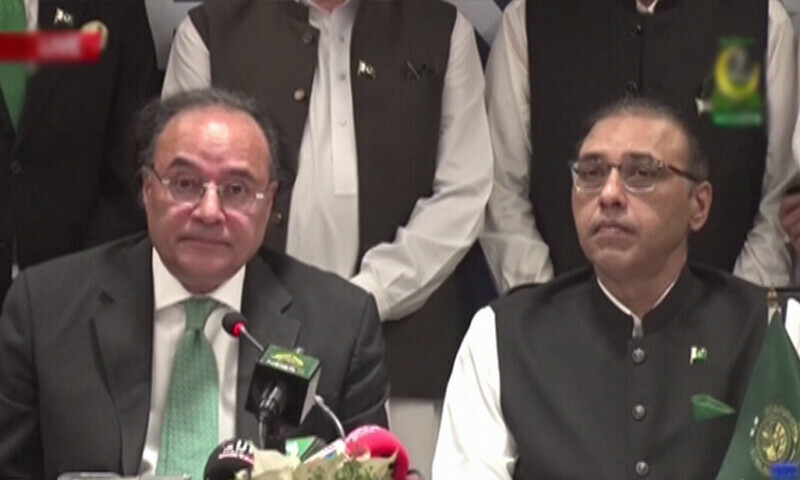
Finance Minister Muhammad Aurangzeb said on Wednesday that there was room for lowering the monetary policy rate by the end of this year.
After slashing the interest rate by 1,000bps from 22 per cent since June 2024 in seven intervals, the State Bank of Pakistan (SBP) has maintained it at 11pc since May. However, the business community has expressed its intense disappointment over the decision.
Addressing an event in Islamabad today, Aurangzeb said: “The monetary policy rate and the market-based exchange rate are very much the purview of the State Bank of Pakistan and the Monetary Policy Committee.
“Having said that, in my personal opinion, I do think there is room to do more in terms of policy rate, and I am very hopeful that during the course of this calendar year, we will see movement on the policy rate going south,” the minister added.
He noted that “whether it was average inflation or core inflation”, there was space for the SBP to lower the rate.
“National security and economic stability are correlated,” Aurangzeb further said.
“In the past 1.5 years, we have made strong progress on the economic front,” he noted, listing: “Increase in the country’s economy and per capita income, stability in the economic sector, record decrease in financial deficit and inflation, improvement in current account surplus and external account, record increase in foreign exchange reserves and remittances.”
He summed up the country’s current economic status: “On the financing costs, we have moved in the right direction. On the energy side, we are beginning to move in the right direction.
“On the taxation side, the fiscal space we had and whatever we could do in this budget, I am very clear in terms of the direction of travel. We need to bring taxation to a regional competitive level,” he added, stressing that expanding the tax nets and closing the loopholes were necessary for that.
Pointing out that international financial institutions had hailed Pakistan’s economic reforms, and that Fitch and S&P Global Ratings had upgraded the country’s credit ratings this year, Aurangzeb said he was hopeful of “the third agency” — an apparent reference to Moody’s — doing the same soon.
Aurangzeb already urged Moody’s in July to improve Pakistan’s current Caa2 credit rating during a virtual engagement in July.
Speaking on the recent trade deal secured with the United States, wherein the tariffs were reduced from 29pc to 19pc, the finance czar hailed the “regionally competitive tariff”.
He recalled Commerce Minister Jam Kamal’s meeting yesterday with leading exporters from various segments and termed it a “fantastic opportunity”.
“What I used to say as part of the private sector, it is necessary to implement that when we are public servants now,” Aurangzeb said.
Noting that he previously gave the example of how “Mumbai does not go to Delhi but Delhi goes to Mumbai” at the time of India’s budget, the minister stressed that the government needs to visit the business community itself for consultations.
Economic sectors
During the media briefing, Aurangzeb also highlighted a “double-digit increase” in exports in the textile, IT and pharmaceutical sectors.
Observing an improved “local business environment”, he added: “SME (small and medium enterprises) loans have increased by 41pc. Should it be even higher? The answer is yes. But 41pc is not a small or insignificant number.
“Loans in the agricultural sector have crossed the Rs2.5 trillion figure. Private sector loans have increased by 38pc,” he added.
The finance czar explained that once fiscal discipline is achieved, the government’s borrowing requirement will decrease, and bank and other economic institutions will reach out to the private sector. The government has significantly increased its borrowing from commercial banks, reaching Rs2.7tr by early May.
He added that the government had reduced its debt servicing by Rs1tr in the past year. “God-willing, our debt servicing will go down by more than 1tr this year as well.”
Recalling his recent meetings with the SBP governor, Aurangzeb emphasised: “We are getting our house in order, which is the federal government. And therefore, it is important that you also take whatever efforts you are making towards the private sector.”
The finance minister also pointed out the record-setting spree at the Pakistan Stock Exchange, which crossed 147,000 points yesterday. He noted a 60pc growth in it, without specifying the timeline.
Aurangzeb highlighted there had been a “record increase” of 65,000 new investors who have come into the PSX over the last year. Company registrations’ annual levels had also gone above 250,000, the minister said, terming both developments as a “big structural change”.
‘Rightsizing of 43 ministries underway’
Speaking about the structural reforms, the minister pointed out the ongoing tariff reforms, which he said were taking place for the first time in Pakistan’s history.
He highlighted that the reforms aim to explore how to reduce the costs of raw materials and intermediate products so that Pakistan could become an export-led economy.
On the government’s rightsizing plan, the finance czar noted that the process for 43 ministries and over 400 departments was underway. He also reaffirmed that the privatisation of state-owned institutions will speed up this year.
The government had moved well past its original June 30 deadline for completing the rightsizing and has written to various ministries to seek their details.
Aurangzeb also pledged further reduction in energy costs due to the savings from the revised agreements with 27 independent power producers earlier this year.
